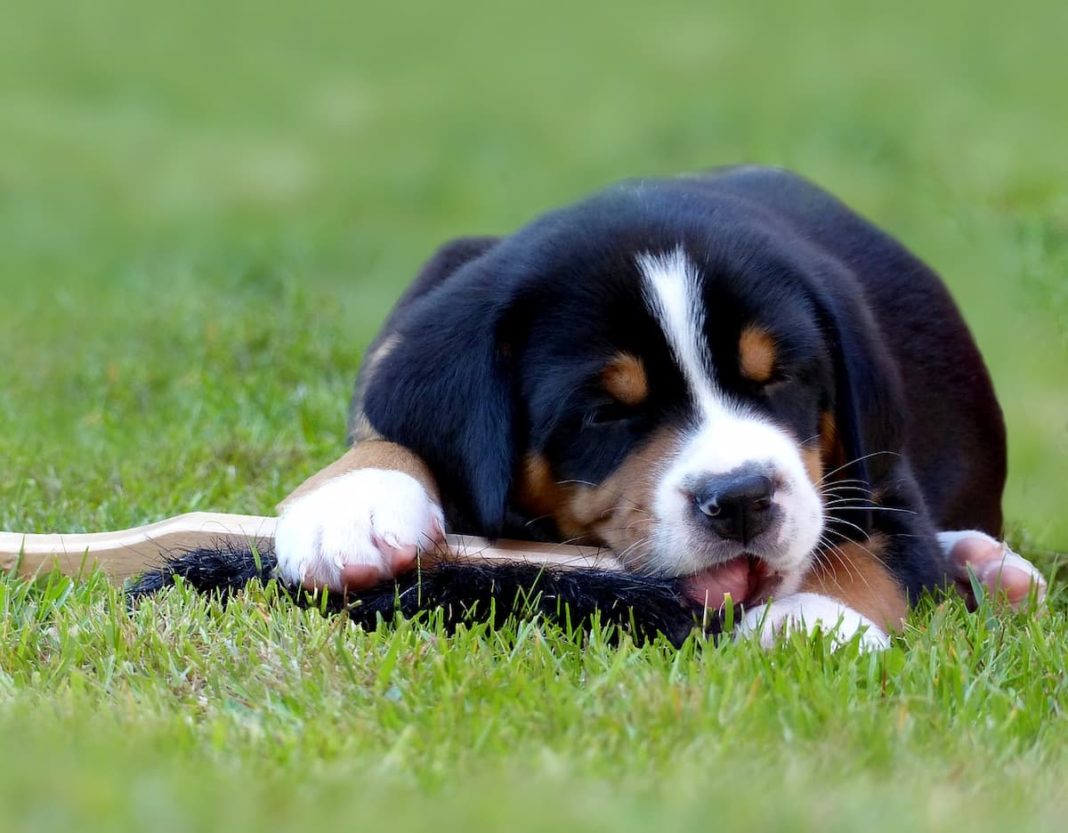Why Is My 16 Week Old Puppy Still Biting?
Quicklinks:
- Teaching Your Puppy Bite Inhibition
- How Biting Stops Naturally
- Teaching Bite Control To A 16 Week Old Puppy
- Teaching Your Puppy What’s A Toy And What’s Not
- Prevention And Persistence Are Key
Besides being massively destructive, a 16 week old puppy can also act like a mini-crocodile. It’s not uncommon for a puppy to bite our clothes, hands, arms, feet, or even our legs. And, boy, can it be annoying! If you’re a puppy owner, you’ll know from experience that those tiny needles that we call puppy teeth can be very painful, and did you know they’re meant to be painful? Puppy’s teeth were designed to cause pain — as you’re already aware, they’re extremely sharp and pointy. If your puppy’s teeth weren’t sharp, they wouldn’t have the opportunity to learn one extremely important skill: bite inhibition.
When a puppy reaches 16 weeks, its teeth will fall out. This can be a frustrating time for a puppy, as their gums are sore and will chew, and bite more! It’s very important to find a safe, age-appropriate puppy chew toys at this point otherwise your pup could try to use you as a chew toy.
Teaching Your Puppy Bite Inhibition
Bite inhibition is something you want your puppy to learn. Simply put, it’s your puppy’s ability to control their jaw by gradually reducing the pressure they apply when they bite. If your puppy has poor bite inhibition, they could cause a great deal of damage if they bite someone. On the other hand, if they’ve gained perfect bite inhibition, then their bites may feel like soft tickles.
Unfortunately, this is not directly related to a level of a puppy’s aggression. If your puppy has an aggression problem but they’ve effectively learned how to inhibit their bites, then the rehabilitation process could be relatively simple. However, if they bite with no control or restraint, then this is something that you need to focus on. The reason why it’s important to teach it from a young age is because bite inhibition can be very difficult to teach in an adult dog, and should ideally be acquired during puppyhood.
How Biting Stops Naturally
The joys of sharing your life with a puppy, the never-ending pee and poop and, of course, the constant biting! This is the perfect moment to continue the process of teaching them bite inhibition. If your puppy had the opportunity to stay with their mother and brothers until they were eight weeks of age, then your 16 week old puppy should have learnt some bite inhibition by now.
When your puppy’s teeth start to come through, they’ll hurt the mother when they try to nurse; the mother will make sure to let them know by pushing them away until they’re gentler. When they’re playing with their brothers and sisters and bite too hard, the other puppies will yelp and move away; therefore, they gradually learn that they need to be gentler, otherwise they won’t get any attention. If your puppy was kept away from their siblings, they wouldn’t off gotten the chance to experience this, which means you’ve got a bit of work to do!
Teaching Bite Control To A 16 Week Old Puppy
Here are some tried and tested methods to help teach your puppy bite control:
- Never allow their teeth to make contact with your skin
- If they bite, shout “ouch!” and stop playing.
- Make life boring (i.e. Don’t grab items and pull them away)
- Prevent the temptation.
- It may be a good idea to seek professional training
How do you teach your puppy to control their tiny, needle-filled mouth? First of all, never allow them to use your hands as chew toys. Their teeth should never touch your skin! If you’re playing with them, make sure to offer them a toy as an outlet; if they bite your hand (even if it’s accidentally), then stop the play session immediately.
You can let them know that they’ve done something that they’re not supposed to by saying “ouch!” and moving away. Wait five minutes, then try again. After a few repetitions, they’ll probably try to be a bit more careful during those play sessions. Some owners tend to play-fight with their puppies, using their hands to tease them; this should be avoided if your pup is still biting hard! Remember, your hands are not chew toys! Rather, use rubber toys, rope, or plastic toys instead—the list is endless.
Teaching Your Puppy What’s A Toy And What’s Not
Some puppies also enjoy biting shoelaces; after all, they’re fun to play with! If your puppy suddenly starts to take a liking to your shoelaces, stop moving. Avoid dragging your pup around, otherwise, you’ll only make them more excited. Instead, to make it boring for the puppy! Stand still and wait. If they let go, reward them by allowing them to play with a more appropriate toy. But, make sure that the toy is more interesting than your shoes; if they’re not into toys, then offer them a yummy treat instead. If they don’t let go and keep pulling the shoelace, you need to redirect their attention. Waiting won’t help as they’re having too much fun! Grab a piece of food (or grab a more interesting chew toy), placing it right in front of your puppy’s nose. They’ll probably lose interest in the shoelace and won’t hesitate to grab the treat. Once they get the idea, be careful not to create a behavioral chain, as they may learn that, in order to get a treat, they need to bite your shoelace; and this isn’t the purpose of the exercise! To prevent this, simply ask them to sit or lie down before giving them the treat.
Prevention And Persistence Are Key
Like in any other behavior problem, prevention is the key. If your puppy is very excited and you think that, they’ll jump right at your hands, offer them the toy beforehand; if they’re running toward your shoes, offer them the chew toy! Persistence and patience are very important; so, make sure to respect your puppy’s learning rhythm!









